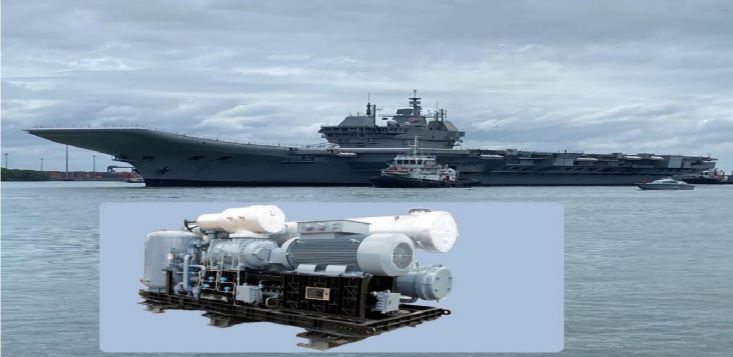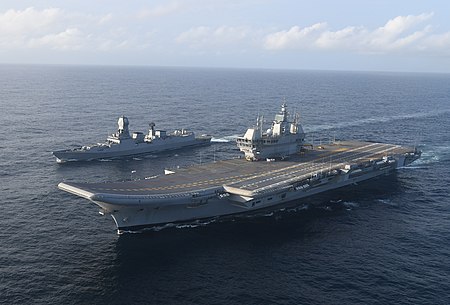News - Kirloskar Limitless
Home-made warrior: Vikrant, India's first indigenous aircraft carrier
Date : August 28, 2022
Link : https://www.tribuneindia.com/news/features/home-made-warrior-426025
Vikrant’s commissioning widens the arc of combat & marks many firsts, as India joins the big league of carrier makers.
Kirloskar Pneumatic Company Limited (KPCL) is proud to be associated with India's First Indigenously Developed Aircraft Carrier - INS Vikrant. KPCL has equipped Vikrant with its largest Air Conditioning & Refrigeration Plants for the Indian Navy.

On October 26, 1949, the Defence Minister’s Committee assessing the needs of the Indian Navy cleared the concept of having two ‘light aircraft carriers’ of our own.
The newly Independent India’s plans stemmed from the impact carriers made during World War II. In April 1942, four months after the Japanese famously hit Pearl Harbour in Hawaii, the US launched its first attack on Tokyo using an aircraft carrier. The ‘B25’ bombers were launched from the deck of USS Hornet to carry out what is known in strategic circles as ‘Doolittle’s Raid’— named after its leader, Lt Col James Doolittle.
A few days from now, on September 2, the first indigenously made 45,000-tonne carrier, Vikrant, will be commissioned at the Cochin Shipyard Limited (CSL) at Kochi, Kerala. Though the Navy has operated three carriers since 1961, all have been second-hand imported ones.
Vikrant is the first to be conceptualized, designed, developed, and built in India. From getting the drawings right to building the warship while integrating the engine, aviation complex, and radars, everything has a first to it. These are technologies no country shares with another country. It is not just the culmination of a two-decade effort to make a carrier, it’s addressing the core of the thought of 1949 — having its own carriers.
The Vice-Chief of the Navy, Vice-Admiral SN Ghormade, says, “The mobility, resilience, integral air power and reach of Vikrant would be a force-multiplier.”
A marvel, no less
Designed with automation for operations, Vikrant widens the combat arc of the Navy. Its engines are the latest and super-powerful. Carriers have hangars to hold fighter jets and helicopters. Vikrant has ship aircraft lifts (to take jets from hangar to deck) with a carrying capacity of 30 tonnes each, designed in a fashion to operate without impeding the flight operations on deck.

“Vikrant is a marvel, it’s five to seven times bigger in size than any warship India has made so far,” explains Madhu Nair, the Chairman and Managing Director of CSL. Some 76 per cent of the budget (approximately Rs 20,000 crore) was spent on equipment and manpower from India. Among others, TATA, L&T, Wartsila, and Kirloskar Pneumatic, along with public sector Bharat Electronics Limited, Hindustan Aeronautics Limited, and Mishra Dhatu Nigam (MIDHANI) shaped the progress.
Flying operations
Imagine a scenario: it is dead of night over the sea. A MiG 29-K fighter, after completing a task, heads back to Vikrant some 400 km away. The pilot locks on to the aviation complex of the ship using a secure link, maintaining what naval aviators term a ‘zip-lip’ procedure or total radio silence.
As the pilot descends, ‘Luna 3E’, an Optical Landing System (OLS) onboard the warship, guides the pilot to a specified ‘descend path’. To explain, the OLS is like an instrument-aided landing system (ILS) used at airports. The fighter jet will approach the deck at 240 km per hour. A set of three, ribbed-steel ‘arrestor wires’— each is 1-inch thick — pop up across the 60-metre-wide deck. The undercarriage of the jet has a tail hook that gets ‘arrested’ in wires and brings the aircraft to stop within 90 metres of touchdown. For taking off, there is a 14-degree inclined ramp shaped like ski-jump to give it a lift.
“Fighter jet trials will commence in November,” says Admiral Ghormade.
Widening the surveillance bubble
Vikrant’s ‘RAN-40L’ radar, provided by European major Leonardo, is a maritime air surveillance and early warning system capable of tracking and detecting aircraft or drones up to 400 km away.
Multiple screens in the control room — called the bridge — show the ship’s Captain the threats. “Sea control is an inherent part of the carrier and its accompanying battle group,” says Commodore Vidhyadhar Harke. He is slated to be the ship’s Captain at commissioning.
Vikrant will also get data from its sensors and imagery from Predator UAVs, the Boeing P8-I surveillance planes and Naval satellite Rukmini. Lt Commander Ajay Singh, tasked in flying operations, says, “The surveillance bubble would be wider and more effective.”
Imported components
Some of the weapons and equipment have been imported. The long range surface-to-air missiles (LRSAM) are Israeli while Russia supplied the aviation complex and the MiG 29-K jets. The propulsion system’s integration has been done by Italian Fincantieri. The ship’s four engines, LM 2500 gas turbines, are from US company General Electric, but HAL played a role in the integration of engines. Integration of all weapon systems would be through an indigenous Combat Management System (CMS).
A long journey
The Central government, in 2003, sanctioned the design and construction of an ‘indigenous aircraft carrier’. The warship designers of the Navy made the drawings. The first symbolic steel cutting was done in 2006, with ship delivery scheduled for 2012. Problems cropped up. The steel did not arrive from Russia. The Indian defence companies were on the ‘entity list’, barred from doing global business after the 1998 nuclear tests.
Government-owned Steel Authority of India, the Navy and DRDO joined hands to produce indigenous warship grade steel ‘DMR 249A and DMR 249B’.
New Delhi took time to get the right type of engines, the gear boxes, pre-launch equipment like diesel alternators, besides materials like steel and cables, etc.
The Ministry of Defence in September 2007 informed Parliament: “The final delivery of the ship may be delayed from the earlier delivery in 2012.” The ship’s keel was finally laid in February 2009. “The complexity of the project and this being the first ship of its kind being built in India led to timelines getting extended,” Navy officials said at a press conference last week.
Contemporary technology in 2 carriers
The commissioning of Vikrant is the first time India would be operating two carriers having contemporary technology — similar long-range radars, same fighter jets, sensors and a matching aviation complex.
India got to operate its first carrier in 1961. The HMS Hercules, sourced second-hand from the UK, was re-named INS Vikrant. It played an important role during the 1971 India-Pakistan war on the eastern front before getting decommissioned in 1997.
India’s second carrier, HMS Hermes, also sourced second-hand from the UK, was re-named INS Viraat. Inducted in 1987, it was decommissioned in 2017. In November 2103, Admiral Gorshkov was refitted and partially recast to be made into a carrier as per Indian specifications and renamed INS Vikramaditya. The two UK-origin carriers operated together between 1987 and 1997, but then both were more than 35 years old. From 2013 to 2017, India again had two carriers. However, Viraat by then was on an extended life cycle.
Asian carrier race
Vikrant’s commissioning is taking place as India and China race to expand their naval strength. China has two operational aircraft carriers — Liaoning and Shandong. In July, it launched another one, Fujian, expected to be commissioned in 2025.
A US Department of Defence report warns that the “People’s Republic of China continues to build a multi-carrier force”. There are plans for six carriers by 2030, it said.
The Indian Navy’s plan for a third carrier has, so far, not been okayed.
Asian countries are racing to project power at sea. The Japanese have JS Izumo, which can fly fighter jets. It’s adding JS Kaga, while South Korea has a plan to launch by 2030 a large-deck amphibious-warfare ship.
How the ship operates
Its four LM 2500 gas turbines have 30,000 Horse power each
- The flight deck is 260 metres long and 1,34,000 sq feet in size, almost equal to two football grounds
- After take-off has been ‘okayed’, a MiG 29K jet will take just three seconds to be airborne from its deck
- The carrier is 15-storey tall, or 61 metres high. It’s a floating city, a walk through all corridors is 8 km
- It can sail for 45 days without refuelling. Its top speed is approximately 55 kmph
- Its onboard power generation of 25 MW, for air-conditioning and other electricity requirements, is the same as a small hydro dam
Crew comfort
- 1,700 personnel, including 110 officers.
- Every crew member has a bunk bed in an air-conditioned compartment.
- Separate accommodation for women.
- Onboard RO system purifies sea water into drinking water.
- Sewage treatment plant treats all waste to a level that it’s safe for marine life.
- Giant automated maker rolls out 2,000 chappatis an hour to serve 600 persons in one go.
- The ship is fitted with a dedicated hospital with CT & ultrasound scanning,
- X-ray machine, operation theatre and a dental clinic.
Putting it together
Industrial suppliers include those in Ambala and Jalandhar
Over 500 Indian firms and 100 MSMEs have contributed to the realisation of Vikrant. Major products on board are sourced from industries located in Ambala, Jalandhar, Bengaluru, Coimbatore, Daman and Diu, Hyderabad, Howrah, Indore, Kutch, Kota, Kanpur, New Delhi, Panaji, Pune, Thiruvananthapuram, Silvassa, Visakhapatnam.
